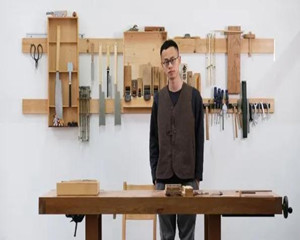(单词翻译:单击)
Yu, 29, is a maker of automata, self-propelled, artistic mechanical figures, in Chengdu, Sichuan province. Automata are built to look like humans or animals and give the illusion of being able to move on their own.
今年29岁的俞宸睿来自四川成都,是一名机关人偶装置艺术家。机关人偶是一种自我驱动的艺术机械人偶,常常被做成人或动物的样子,通过机关让他们“自己动起来”。
"The art form amazes me, because it integrates various skills, from storytelling to mechanics, and the pieces are built with a sense of humor," Yu says.
俞宸睿说:“这种艺术形式真的很惊艳,它融合了很多项不同的技术,从讲故事到机械内核统统都有涉及。同时,这些零件本身也充满了幽默感。”
In an age of technology, this is undoubtedly a marginal sector. Yu estimates that it has attracted no more than 10 full-time makers and practitioners across the country. His creations have caught the attention of renowned artists, such as Paul Spooner from the home of automata making in the United Kingdom and Kazuaki Harada from Japan.
在这个科技至上的年代,机关人偶制作者无疑是一个边缘职业。俞宸睿估计全国不超过10名全职制作者。他的创作则吸引了这个领域的一些著名艺术家,例如来自机关人偶诞生地的英国艺术家保罗·斯普纳和日本机关人偶大师原田和明。
On social media, Spooner applauded Yu as "a great practitioner". In February, Kazuaki recommended him for the Automata Program during this year's World Wood Day.
在社交媒体上,斯普纳称赞俞宸睿是“伟大的实践者”。今年2月,原田和明推荐他参加世界木材日举办的机关人偶项目。
With prices ranging from hundreds to tens of thousands of yuan, his whimsical pieces of art have attracted collectors worldwide.
俞宸睿极具创造力的作品吸引了世界各地的收藏家,价格从数百元到上万元不等。
"A fascinating thing about automata is that it delights people of all ages. Adults appreciate them as art, while children see them as toys to be played with," Yu says, smiling.
俞宸睿笑着说:“机关人偶装置的迷人之处在于它的受众没有任何年龄限制,成年人会将它们当作艺术品欣赏,同时,孩子们也可以把它们当作玩具。”
The automata story has its origins in ancient Greece. Indeed, the name comes from the Greek word automatos, meaning "moves on its own". Automata were the first complex machines produced by man, and the mechanical principles applied haven't changed for thousands of years.
机关人偶起源于古希腊,这项技术的名字就来源于古希腊词语automatos,意为“自行移动”。机关人偶装置是人类创造出的第一种复杂机械,而其应用的机械原理几千年来都没有发生改变。

Going Against the Grain
特立独行
Interested in handcrafts as a boy, Yu first encountered automata designed by Kazuaki at an exhibition in 2015 when he studied at the Communication University of China in Beijing. "It was like meeting a like-minded friend," Yu says, recalling the moment.
俞宸睿对手工艺品的兴趣很早就有所体现。2015年还在中国传媒大学读书的他,在一次展览上首次接触到了原田和明设计的机关人偶,他回忆道:“这感觉就像找到了一个相见恨晚的朋友。”
As an art and design major, he began to learn the craft by himself and, with the support of his tutor, he kept studying and examining automata in school. The pieces that seem to move effortlessly take a beginner a long time to make. It can take Yu more than a year to ensure his mechanical sculptures move smoothly.
作为艺术与设计专业的学生,俞宸睿开始自己学习机关人偶,并在导师的支持下,继续在学校学习和研究这项技术。对初学者来说,那些移动起来看似毫不费力的零件需要很长时间来制作。一年多的反复试验后,俞宸睿的人偶终于能顺利移动起来。
When he graduated in 2016, Yu landed a job at an advertising agency near Shichahai, a popular scenic area in Beijing. He stayed on at the company for three years because, at that time, he was not sure that he could make a living out of his hobby.
2016年毕业后,俞宸睿入职了一家广告公司,地处北京热门景点什刹海附近。那时他还不确定机关人偶这个兴趣爱好能不能养活自己,为了维持生计,他在这家公司工作了三年。
While working as a designer, Yu kept exploring and advancing his skills in wood carving and mechanics. Eventually, though, despite the job's good salary, it was not enough to compensate for not following his true passion. Every day, when he walked alone along the Shichahai lake, he watched ducks swimming, foraging and diving. He envied, in a way, their freedom to do as they pleased.
在工作的闲暇时光里,俞宸睿一直不断探索和提高他在木雕和机械方面的技术。虽然广告公司设计师的薪水非常可观,但是物质上的收入已不足以弥补他热爱的缺失。每天,当他独自一人在什刹海湖畔散步,看着湖里鸭子游泳、觅食、潜水,他打心眼儿里羡慕它们的自由和随心所欲。
"Every time I would encounter the ducks, I would ask myself if I was doing what I wanted, and if I was happy with my life," Yu remembers.
俞宸睿回忆说,“每次看到这群鸭子,我都会问自己我在做我想做的事情吗,我对现在的生活满意吗。”
The ducks inspired his automaton creation entitled Search for Self, in which a duckling swims happily in a circle. At the same time, an older duck seems unsure of what its life is about. The younger bird seems unconcerned, and is just happy to play.
鸭群激发了他的灵感,随机创作出了机关人偶作品《找自己》。在这个装置中,有一只小鸭子在快乐地打着圈儿,一只年长的鸭子则对生活有些迷茫。年轻的鸟儿则似乎毫不在意,只是很高兴地玩耍。
At an exhibition, when a girl saw the piece and asked why the duck kept searching but finding nothing, Yu heard her grandmother's interpretation, which of course was exactly how he wanted the piece to be explained. The grandmother said that, because humans change as time goes by, searching for yourself is a lifelong process, and doubts may come with age.
在一次展览中,一个小女孩看到了这幅作品,她问奶奶为什么鸭子一直在寻找却什么也没找到。俞宸睿听到奶奶回答说,因为人们会随着时间的流逝而改变,疑惑会随之而来,而寻找自我是一个一生的过程。俞宸睿表示,老奶奶的解释就是他想透过这幅作品表达的意义。
Finally, in 2018, Yu quit his job and returned to Chengdu to open his automata workshop. The studio he rents exceeds 200 square meters, and Yu has spent more than 300,000 yuan ($46,000) refurbishing it.
最终,俞宸睿在2018年辞去了工作,回到成都开设了自己的机关人偶工作室。他租用的工作室超过200平方米,花费了超过30万元人民币(46,000美元)翻新。
Just after finishing the renovation, Yu didn't know what to do and worried about cash flow. To keep himself occupied he planted blueberries, raspberries and cherries. He watered, weeded and added fertilizer every day.
刚完成装修后,因为没有接到什么工作,所以俞宸睿非常担心工作室的现金流。为了让自己的日子变得充实起来,他会种种蓝莓、覆盆子、樱桃等植物,每天给它们浇水、除草、施肥。
"Daily routines helped me calm down and reignited my creativity, which resulted in an automaton called To Observe the Autumn," Yu says. The pendulum installation tries to show how lovely and short autumn is.
“日常的规律活动可以让我平静下来,并且可以激发我的灵感”,俞宸睿采访时表示。这些日常生活最终体现在了《秋天观察》这个作品上,其中,钟摆的设计是为了体现秋天的美丽和易逝。
Over time, Yu's reputation grew and his business flourished.
久而久之,俞宸睿的名声逐渐打开,工作室的生意也越来越好了。
Many of Yu's creations are built with a dash of wisdom, a sprinkle of humor and are inspired by observations of real life. Woodcutter and Worm is derived from his own experience of finding a wormhole while cutting wood.
俞宸睿的许多创作都带着些许智慧,些许幽默,来源于对生活的观察。《樵夫与虫》这个作品就是源自他自己在做木工时找虫眼的亲身经历。
Yu knows that there are many more creative ideas waiting to be expressed. "It feels quite good to be fully devoted to automata creation and I am still searching for myself."
俞宸睿知道还有许多创意等着被表达、呈现,“专注于机关人偶装置艺术创作很幸福,我也仍在继续寻找自我。”
Although the origin of automata dates back thousands of years, Yu doesn't reject applying modern techniques. "Modern technology makes mass production of my automata possible, which can make the art form more popular and allow it to be enjoyed by more people," he says.
尽管机关人偶的起源可以追溯到数千年前,但俞宸睿并不拒绝应用现代技术,“现代科技使大规模生产机关人偶成为可能,这可以使这种艺术形式更受欢迎,进而让更多的人喜欢它。”
"I hope it can be enjoyed by people of all ages, and makes them feel more connected and happier," Yu says.
俞宸睿表示:“我希望各个年龄段的人都可以享受机关人偶装置这项艺术,让自己与世界更亲近、更快乐。”


